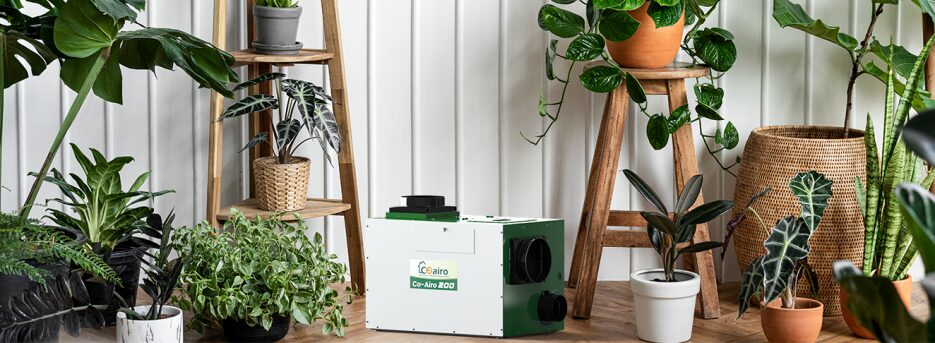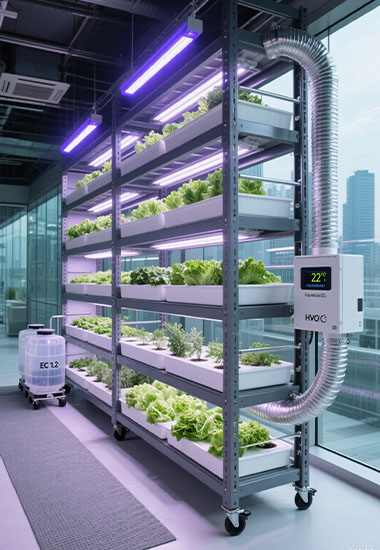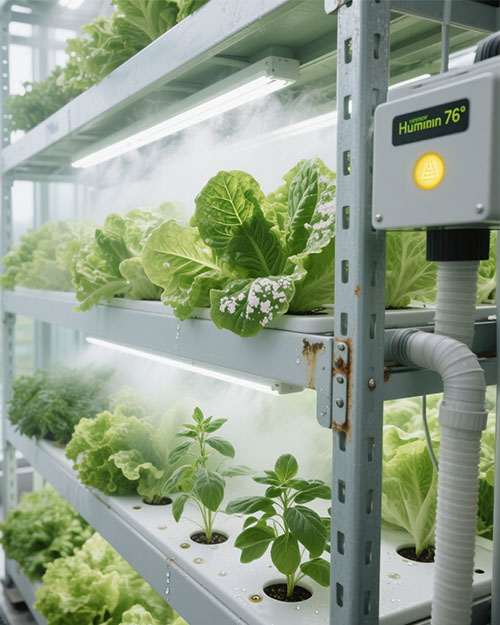
Humidity Management in Vertical Farms: Precise Humidity Control in High-Density Cultivation
Humidity management in vertical farms is one of the most important factors affecting yield and quality. A 5% change in moisture level can make or break crops. Vertical farms with their efficient three dimension production layout use shelf-based systems to maximize output in limited space. But these enclosed environments accumulate moisture naturally and present unique challenges in maintaining stable humidity.
Keeping relative humidity (RH) within the optimal range of 40% to 60% ensures plants get ideal growing conditions. Moderate humidity promotes photosynthesis, healthy growth and nutrient and water absorption. Without proper regulation, even a small increase in RH can shorten grain storage life or encourage disease outbreaks. For high-density vertical farming precise humidity control is essential.

Introduction to Vertical Farm Cultivation Structure
Vertical farming is a modern way of growing plants that uses stacked layers instead of spreading crops over large fields. It’s mainly done indoors in a controlled environment and is becoming popular in cities where land is limited.
In vertical farms, plants grow on shelves, racks or towers in multiple layers, sometimes several stories high. These systems are often set up in warehouses, shipping containers, greenhouses or specially built facilities. The enclosed environment allows farmers to control temperature, lighting, humidity, watering and nutrients for ideal plant growth.
The core of vertical farms is shelf-based cultivation systems which include:
- Steel racks and shelves for strength and pest resistance
- Multi-tier mobile carriages to optimize space
- Movable tabletop units for flexible use
- Heavy-duty shelves to support plants, irrigation, lighting and climate systems
Steel is a common material because it’s strong, easy to clean and can handle the humid indoor environment. These shelves must support plants, irrigation systems, lighting and sometimes small HVAC units.
One big advantage is space saving. Stacking plants vertically can produce up to 10 times more food per square meter compared to traditional farming. This method also integrates Controlled Environment Agriculture (CEA) technology which maintains perfect growing conditions year-round. But the enclosed space design can lead to moisture buildup making humidity control an essential part of vertical farming success.
Drawbacks of Vertical Cultivation: Moisture Accumulation and Excessive Humidity
While vertical farming has many advantages, moisture management is one of its biggest challenges. Plants release water vapor through transpiration. In a vertical farm with plants stacked close together, the amount of moisture released into the air is much higher than in open fields.
Since these farms are enclosed, the moisture has nowhere to escape. Over time humidity builds up and water droplets may form on walls, ceilings and equipment. This excessive humidity can cause:
- Plant diseases– Fungal infections like powdery mildew and botrytis grow fast in damp environments and damage crops and reduce yields.
- Slower plant growth– When humidity is too high, plants struggle to absorb nutrients and grow weaker.
- Equipment damage– Moisture can corrode shelves, affect lighting systems and encourage mold growth.
- Food safety risks– High humidity creates a breeding ground for bacteria and microorganisms which can affect produce quality.
If humidity is not managed well, losses in crop yield can be significant. Humidity that is too low, below 30% can also harm plants, resulting in slower growth and lower photosynthesis efficiency. The “sweet spot” depends on the crop type.
For example, lettuce grows best at 75% humidity, basil at 55%. Maintaining the right range for each crop is challenging when hundreds or thousands of plants produce moisture in a small space.

Solutions: Install Dehumidifiers in the Top Space for Wide Coverage and High Efficiency
The most effective way to manage humidity in vertical farms is by using overhead dehumidifiers. These are installed in the upper part of the growing area so they can capture the rising warm and moist air and distribute dry air evenly across all levels.
Here’s why this approach works so well:
1) Strategic Placement
Installing dehumidifiers at the top shelf allows them to draw in the air with the most moisture content before it forms water on ceilings or walls. This allows dry air to flow downwards through the plants and balances the climate in all the shelves.
2) Wide Coverage
For large farms, one unit may not be sufficient. Putting multiple units strategically throughout the growing space will make the humidity consistent. The air from the units must be able to circulate throughout the room, so there are no hotspots with condensation.
3) High Efficiency
The modern agricultural dehumidifiers are designed for long-term use and can be integrated into an existing HVAC system. This controls temperature and humidity in a single system. Some models like Coairo’s also have water recovery systems. This means the moisture collected from the air can be reused for irrigation reducing water costs and waste.
4) Energy Considerations
Humidity control systems can consume a lot of energy especially when running 24/7. Choosing energy efficient models with features like remote condensers (which release heat outside) can lower operational costs. Regular maintenance like cleaning filters and coils keeps them working at maximum efficiency.
5) Crop Specific Settings
Different crops require different humidity levels. Using adjustable dehumidifiers allows farmers to fine tune conditions for each crop type. This precision prevents diseases and supports optimal growth.

Why Coairo Dehumidifiers are Best for Vertical Farms
Coairo designs high precision humidity control systems specifically for demanding environments like vertical farms. The key benefits include:
- Humidity control ±5%:Keeps crops in their optimal range for peak yield and quality.
- Wide coverage, even in multi-tier setup: Strategic airflow design reaches all shelves and layers.
- Integration-ready systems: Seamless compatibility with existing environmental control platforms.
- High efficiency under heavy loads: Stable performance despite heat from lighting and dense plant transpiration.
- Sustainable water use: Options for moisture capture and reuse to reduce resource consumption.
Coairo’s systems are not generic dehumidifiers. They are engineered for continuous operation in high moisture, high density environments delivering consistent results while minimizing energy costs.
Conclusion
Vertical farming offers many opportunities for year round high yield crop production in minimal space. But without precise humidity management that opportunity is quickly lost to disease, growth issues and wasted resources. Coairo’s high precision dehumidifiers are designed for these demanding environments. It offers consistent moisture control, energy efficiency and water conservation benefits.
Contact Coairo.com to upgrade your vertical farm’s climate control today.